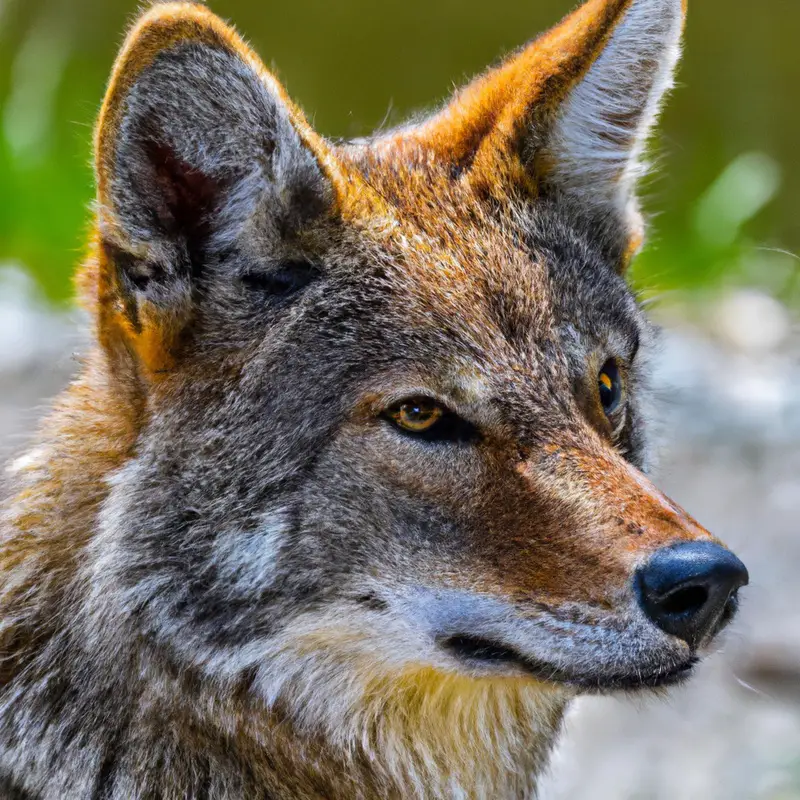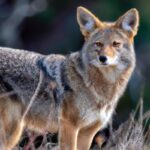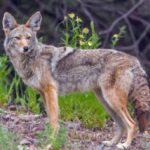Key Takeaways:
- Coyote hunting is a popular activity in Arizona.
- Hunting regulations for coyotes in Arizona are relatively flexible.
- Arizona offers a variety of hunting methods for coyotes.
- Coyote hunting can help manage their population and protect livestock.
Are you ready for an adrenaline-pumping adventure in the beautiful deserts of Arizona? I sure am! Today, I want to share with you everything you need to know about hunting coyotes in the great state of Arizona.
From understanding their behavior and population to the essential gear and hunting techniques, we’ll cover it all.
Plus, we’ll dive into the legal regulations, safety tips, and even some sneaky tricks for a successful hunt. So, grab your gear and join me on this wild coyote-hunting journey in Arizona!
| Coyote Hunting in Arizona |
|---|
| Pros |
| Effective method for controlling coyote population |
| Helps protect livestock and domestic pets |
| Provides recreational opportunities for hunters |
| Can help reduce the risk of diseases transmitted by coyotes |
| May contribute to the preservation of endangered species |
| Cons |
| Controversial practice with ethical concerns |
| Extensive hunting can disrupt the ecosystem |
| Requires a high level of expertise and knowledge |
| Can pose risks to hunters and bystanders |
| Eating coyote meat may carry health risks |
Guide to Hunting Coyote in Arizona
Understanding Coyote Behavior in Arizona
Coyotes in Arizona can be both fascinating and elusive creatures.
Understanding their behavior is key to hunting them effectively.
Here are a few important things to know:
- Coyote Communication: These intelligent animals communicate through a variety of vocalizations, including howls, barks, and yips. Pay attention to their calls to locate them and potentially lure them closer.
- Hunting Patterns: Coyotes are most active during dawn and dusk, making these the best times to hunt. They often travel in pairs or small groups, so if you spot one, there may be others nearby.
- Territory and Marking: Coyotes are territorial and mark their territory with urine, feces, and scent glands. Look for marking posts and areas with high activity to increase your chances of spotting them.
- Habitat Preferences: Coyotes in Arizona can be found in a variety of habitats, including deserts, grasslands, and mountains. Focus your hunting efforts in areas where they are likely to seek shelter and find food.
- Food Sources: Coyotes are opportunistic eaters and will prey on small mammals, birds, reptiles, and even fruits and vegetables. Understanding their diet can help you determine the best bait or calls to use during your hunt.
By familiarizing yourself with coyote behavior in Arizona, you can improve your chances of a successful hunt.
Remember to always follow local hunting regulations and practice ethical hunting practices.
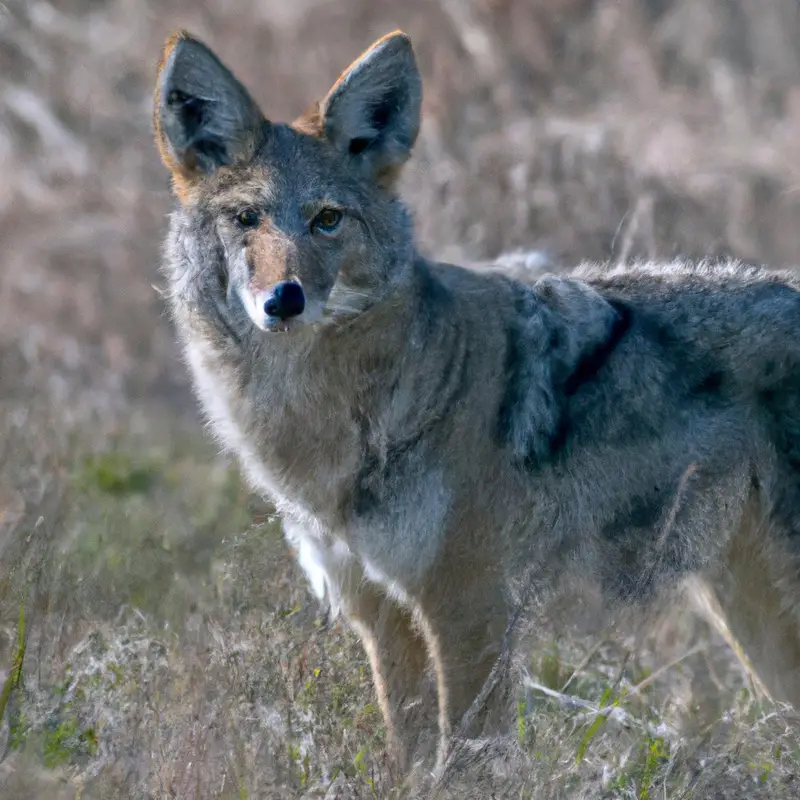
Coyote habits and habitats
Coyotes are highly adaptable animals that can be found in a variety of habitats across Arizona. They have a wide range of habits that allow them to thrive in different environments.
They are primarily nocturnal, meaning they are most active at night.
Coyotes are opportunistic feeders and have a diverse diet that includes small mammals, birds, insects, fruits, and carrion. They are also known to scavenge from human settlements, making them highly adaptable to urban and suburban areas.
In terms of habitats, coyotes can be found in forests, deserts, grasslands, and even in densely populated areas.
They typically den in underground burrows, but may also utilize caves, rock crevices, or dense vegetation for shelter. Understanding coyote habits and habitats is essential when hunting them, as it allows hunters to anticipate their behavior and maximize their chances of success.
Coyote population in Arizona
The coyote population in Arizona is quite robust.
These intelligent and adaptable creatures are found throughout the state, from the sprawling deserts to the mountainous regions.
Their population is influenced by several factors, including availability of food, water, and suitable habitat.
Coyotes are known for their ability to thrive in diverse environments and have even adapted to urban areas.
Conservation efforts and hunting regulations help to maintain a healthy balance between the coyote population and the ecosystem.
If you are interested in hunting coyotes in Arizona, make sure to familiarize yourself with the hunting regulations and seek the necessary permits.
Happy hunting!
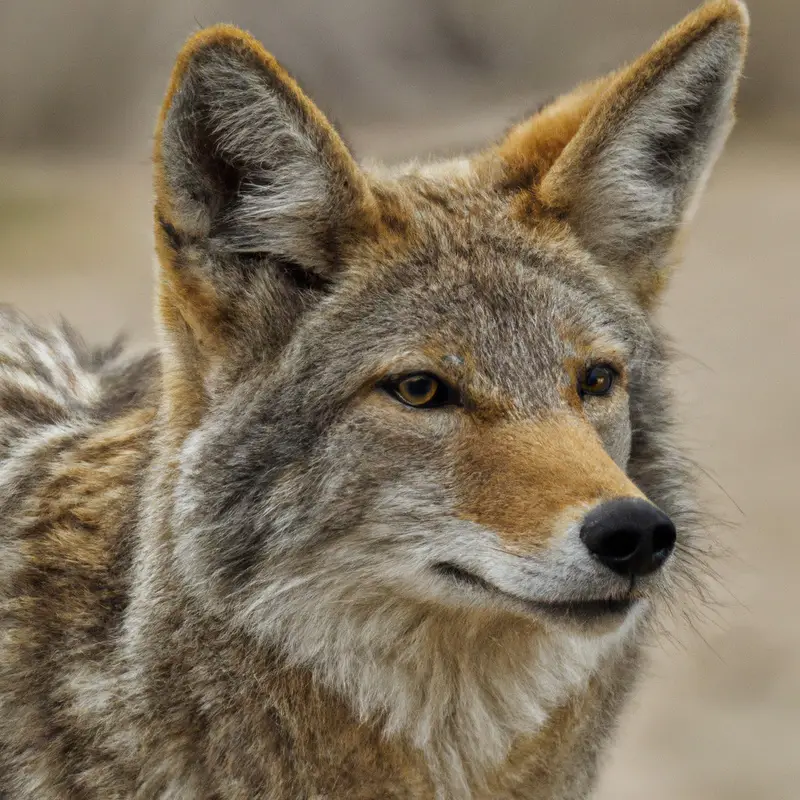
Coyote hunting season in Arizona
In Arizona, the coyote hunting season runs all year round.
There are no specific dates or restrictions for hunting coyotes in the state.
This means that you have the flexibility to hunt coyotes whenever you want, as long as you abide by the state’s hunting regulations and obtain the necessary permits and licenses.
It’s important to familiarize yourself with the rules and regulations governing hunting in Arizona to ensure a safe and legal hunting experience.
Remember to always prioritize safety and respect for wildlife while enjoying your coyote hunting adventures in Arizona.
Essential Gear for Coyote Hunting
Essential Gear for Coyote Hunting As a seasoned hunter, I can tell you that having the right gear can make all the difference when it comes to coyote hunting.
Here are some must-have items to ensure a successful hunt:
- Quality camouflage: Blend into your surroundings with a camouflage jacket, pants, and hat. This will help you stay hidden from the keen eyesight of coyotes.
- Binoculars: Spotting coyotes from a distance is crucial. Invest in a pair of good-quality binoculars to improve your chances of spotting them before they spot you.
- Calls: Coyotes are highly vocal animals, and using the right calls can attract them towards your location. Get a variety of distress calls, howlers, and prey calls to maximize your chances of luring them in.
- Decoys: Coyotes are curious creatures, and a decoy can be a great tool to bring them within range. Opt for a realistic-looking coyote decoy to entice them and create a believable setup.
- Hunting rifle: A reliable and accurate hunting rifle is essential for taking down coyotes. Choose one that is suitable for medium-range shooting and chambered in a caliber appropriate for coyote hunting.
- Ammunition: Load up on high-quality ammunition designed for coyote hunting. Opt for light, fast bullets that provide good penetration and minimal ricochet.
- Hunting backpack: A good quality backpack with plenty of pockets and compartments will keep your gear organized and easily accessible during your hunt.
Remember, always check your local regulations and ensure you have the appropriate licenses before heading out.
With the right gear and a little patience, you’ll be well-equipped for a successful coyote hunt.
Happy hunting!
Firearms and ammunition
Firearms and ammunition are essential tools for hunting coyotes in Arizona. Choosing the right firearm is crucial for success.
Typically, hunters opt for rifles in .223 or .243 caliber, as these offer a good combination of accuracy and stopping power.
Semi-automatic or bolt-action rifles are popular choices. It’s important to select ammunition that is appropriate for coyote hunting, such as varmint or hollow point rounds.
Additionally, a scope can improve accuracy, especially for long-distance shots.
Always ensure you are familiar with and follow local firearm regulations and safety guidelines.
Calls and decoys
Calls and decoys play a crucial role in coyote hunting.
One effective call is the coyote howler, which mimics their vocalizations and can attract them.
You can also use distress calls, imitating wounded prey to attract coyotes.
Decoys, such as coyote or rabbit replicas, can add a visual element to lure coyotes closer.
It’s essential to set up your calls and decoys strategically, considering wind direction and terrain.
Experiment with different calls and decoys to see what works best in your hunting area.

Camouflage and scent control
Camouflage and scent control are essential when hunting coyotes in Arizona.
To blend into your surroundings, choose camouflage clothing that matches the local vegetation and terrain.
This will help you stay hidden and increase your chances of success.
Additionally, pay attention to your scent by using scent control products such as scent eliminating sprays or scent-blocking garments.
Coyotes have a keen sense of smell, so taking steps to minimize your scent will help keep you undetected.
Remember, being invisible and scent-free is crucial for a successful hunt.
Optics and navigation tools
Optics and navigation tools are essential for successful coyote hunting in Arizona. A good pair of binoculars will help you spot these elusive creatures from a distance, and a rifle scope with high magnification will improve your accuracy when taking the shot.
Additionally, a reliable GPS device or smartphone app can assist you in navigating the vast and sometimes challenging terrain in Arizona.
Having these tools handy will increase your chances of a successful hunt.
Hunting Techniques for Coyote in Arizona
When hunting coyotes in Arizona, it’s essential to use effective techniques that maximize your chances of success. Here are some hunting techniques you can employ:
- Spot and stalk: Look for coyotes in open areas where they may be hunting for prey. Use binoculars to scan the terrain and identify potential targets. Move slowly and quietly, taking advantage of cover to remain undetected.
- Calling: Coyotes are attracted to the sounds of their prey, so using electronic or mouth calls can be effective. Mimic the distress calls of small animals or use coyote vocalizations to draw them in. Be patient and use different calls until you find one that works.
- Setting up decoys: Placing realistic decoys like a distressed rabbit or wounded bird near your position can lure coyotes into range. Position yourself downwind from the decoy to avoid being detected and ensure a clear line of sight.
- Night hunting: Coyotes are more active at night, so consider using night vision equipment or thermal scopes to enhance your chances. Use caution and know the local regulations regarding night hunting.
Remember to dress in camouflage, pay attention to wind direction, and practice good shot placement. Always prioritize safety and adhere to local hunting laws and regulations.
Spot and stalk
Spot and stalk is a popular hunting technique used for hunting coyotes in Arizona. In this method, you rely on your ability to spot the coyote from a distance and then quietly and slowly stalk closer for a shot opportunity.
The key is to remain patient, using the available cover and terrain to conceal your approach.
Move slowly, keeping an eye on the coyote’s behavior and any potential wind shifts that could give away your scent. Once you’re within range, take a steady shot and ensure a clean kill.
It requires skill, patience, and adaptability to succeed with spot and stalk hunting.
Predator calling
Predator calling is an effective technique used in coyote hunting.
It involves using various devices, such as electronic calls or mouth calls, to mimic the sounds of injured prey animals.
This attracts coyotes and brings them within range for a clean shot.
When using predator calls, it’s important to choose the right sound and volume for the specific hunting location and conditions.
Additionally, using camouflage and concealment techniques will increase your chances of success.
Keep in mind that practice is key, so spend time perfecting your calling skills before heading out into the field.
Hunting during day or night
Hunting during the day or night is a matter of personal preference and strategy. During the day, you can rely on visibility to spot coyotes and have a clearer shot.
However, coyotes are often more active at night, making it a good time to hunt if you’re equipped with night vision or thermal imaging devices.
Remember to check local regulations and obtain the necessary permits. Ultimately, the best time to hunt depends on your comfort level, equipment, and understanding of coyote behavior.
Happy hunting!
Proper shot placement
Proper shot placement is essential when hunting coyotes in Arizona.
Aim for vital areas such as the heart, lungs, and brain to ensure a quick and humane kill.
The heart shot is reliable if you have a clear and safe shot, while a shot to the lungs will also bring down the animal effectively.
Another effective approach is targeting the brain, which requires precision and accuracy.
Avoid shooting in non-vital areas to prevent unnecessary suffering.
Always prioritize a clean and ethical shot when hunting coyotes.
Legal Regulations and Licensing
Legal Regulations and Licensing for hunting coyotes in Arizona are essential to ensure the sustainability of the wildlife population and protect the environment. In Arizona, you must possess a valid hunting license to legally hunt coyotes.
The Arizona Game and Fish Department regulates hunting seasons and sets bag limits for coyote hunting.
It’s important to familiarize yourself with the specific regulations and obtain the necessary licenses before heading out to hunt. Additionally, make sure to follow any supplemental regulations that may apply to specific areas or hunting methods, such as the use of artificial lights or electronic calls.
Always abide by the rules and respect the land and wildlife.
Coyote hunting license requirements
To legally hunt coyotes in Arizona, you must have a valid hunting license.
Additionally, you must possess a predator or combination hunting license, which specifically allows for the hunting of coyotes.
These licenses can be obtained from the Arizona Game and Fish Department’s website or from authorized license dealers.
It’s important to ensure that your license is up-to-date and that you comply with all hunting regulations, including bag limits and hunting seasons.
Staying informed and following these requirements will help you enjoy a safe and legal coyote hunting experience.
Bag limits and hunting zones
Bag limits and hunting zones in Arizona are important factors to consider when hunting coyotes. The bag limit refers to the maximum number of coyotes that a hunter can legally harvest in a given time period.
It is crucial to abide by these limits to ensure the sustainability and conservation of coyote populations.
Additionally, hunters must be aware of the designated hunting zones in Arizona, as certain areas may have specific regulations or restrictions. Understanding and respecting these bag limits and hunting zones is essential for responsible and legal coyote hunting in Arizona.
Important regulations to adhere to
Important regulations to adhere to when hunting coyote in Arizona include obtaining the necessary licenses and permits, adhering to the designated hunting seasons and bag limits, and following the specific regulations of the area you are hunting in. It is also important to practice ethical hunting, which includes using legal hunting methods and respecting private property.
Additionally, being knowledgeable about firearm safety and practicing responsible hunting behavior is crucial.
Always remember to stay informed about any changes to hunting regulations and abide by them.
Safety Tips for Coyote Hunting in Arizona
When hunting coyotes in Arizona, it’s important to prioritize safety.
Here are some tips to keep in mind:
- Always wear proper hunting gear, including blaze orange for visibility.
- Familiarize yourself with Arizona’s hunting regulations and obtain the necessary licenses and permits.
- Be aware of your surroundings and be sure of your target before taking a shot.
- Communicate with other hunters in your group to avoid accidental injury.
- Practice firearm safety by keeping your weapon unloaded until ready to use and always pointing it in a safe direction.
- Be prepared for changing weather conditions and carry essential supplies such as water, first aid kit, and a means of communication.
- Respect private property and obtain permission from landowners before hunting on their land.
- Let someone know your hunting plans and expected return time for added safety.
- Consider hunting with a partner for increased safety and assistance, if needed.
Remember, safety should always be your top priority when hunting coyotes in Arizona.
Basic firearm safety rules
Basic firearm safety rules are essential to ensure the safety of yourself and those around you.
Here are some important guidelines to follow when handling firearms:
- Always treat every firearm as if it is loaded, even if you believe it to be unloaded. Check the chamber and magazine before handling.
- Keep your finger off the trigger until you are ready to shoot. Only place your finger on the trigger when you have identified the target and are prepared to fire.
- Point the muzzle in a safe direction at all times. Be aware of your surroundings and avoid pointing the firearm at anything you do not intend to shoot.
- Be sure of your target and what is beyond it. Never shoot at something unless you are certain of what lies beyond it, as bullets can travel far distances.
- Store firearms securely when not in use. Use a locked gun cabinet, safe, or trigger lock to prevent unauthorized access.
- Use appropriate ammunition for your firearm. Check the caliber or gauge marked on the firearm and match it to the ammunition you are using.
- Seek proper training and familiarize yourself with the specific operation and safety features of the firearm you are using.
Remember, firearm safety should always be your top priority.
By adhering to these basic rules, you can help prevent accidents and promote responsible gun ownership.
Stay safe and enjoy your time hunting coyotes in Arizona.
Protective clothing and gear
Protective clothing and gear are essential when hunting coyotes in Arizona.
- Dress in layers to regulate body temperature and stay comfortable throughout the day.
- Wear camouflage clothing to blend in with the surroundings and avoid detection.
- Use proper footwear, like comfortable and durable boots, to navigate various terrains.
- Protect your eyes with sunglasses or protective goggles to shield against dust, debris, and the sun’s glare.
- A sturdy hat or cap can provide additional protection from the sun.
- Don’t forget to wear gloves to protect your hands from injury and keep them warm.
- Carry a backpack or pouch to store necessary items like water, snacks, ammunition, and calls.
- Use high-quality binoculars or a spotting scope to spot coyotes from a distance.
- Consider using a durable hunting pack to carry any harvested game back.
- Lastly, always prioritize safety by wearing ear protection and following firearm safety protocols.
Hunting in groups or alone
When it comes to hunting coyote in Arizona, you have the option of hunting in groups or going alone.
Both methods have their advantages and it ultimately depends on your personal preference and hunting style.
Hunting in groups allows for better coverage of an area and increased chances of spotting coyotes.
You can divide the area into sections and have multiple hunters stationed at different locations.
This can help in tracking and ambushing coyotes more effectively.
On the other hand, hunting alone provides a quieter and more stealthy approach.
You have complete control over your movements and can focus on your own strategy.
Solo hunting also allows you to react quickly to any opportunities that arise.
Ultimately, whether you choose to hunt in groups or alone, it’s important to prioritize safety and follow ethical hunting practices.
Coyote Hunting Tips and Tricks
Here are some tips and tricks to help you have a successful coyote hunting experience in Arizona:
- Scout your hunting area beforehand to locate areas where coyotes are likely to be found, such as near water sources or in open fields.
- Use predator calls, such as distress calls or howls, to attract coyotes. Experiment with different calls to see what works best in your hunting spot.
- Set up your hunting position downwind of the area where you expect coyotes to approach. This will help mask your scent and increase your chances of a successful hunt.
- Camouflage yourself and your equipment to blend in with the surroundings. Coyotes have keen eyesight and can easily spot anything out of place.
- Practice patience and remain still. Coyotes are cautious animals, and any sudden movement or noise can spook them.
- Consider hunting in pairs or small groups. Having multiple hunters can increase your chances of spotting coyotes and executing a successful hunt.
- Aim for a clean shot to ensure an ethical kill. Coyotes are fast and agile, so make sure you have a clear line of sight before taking a shot.
- Follow all state regulations and obtain the necessary hunting licenses and permits before heading out.
Happy hunting! Remember to prioritize safety and respect for the environment while enjoying your time in the field.
Scouting for coyote signs
When scouting for coyote signs, there are a few key indicators to look out for. Firstly, keep an eye out for tracks.
Coyote tracks typically resemble small dog prints, with claw marks visible.
Secondly, look for scat or droppings, which often appear in small piles and may contain fur or bone fragments. Thirdly, listen for coyote howls or yips during dawn and dusk, as this indicates their presence.
Additionally, pay attention to any signs of burrows or dens in the area.
By being observant and familiarizing yourself with these signs, you’ll increase your chances of locating coyotes during your hunt.
Using wind and terrain to your advantage
Using wind and terrain to your advantage is key when hunting coyote in Arizona.
Pay attention to the wind direction as coyotes have a keen sense of smell.
Position yourself upwind from their usual path to mask your scent.
Utilize natural terrain features such as hills, valleys, and brush for cover and to gain better visibility.
Stealthily navigating the terrain can help you get closer to your target without being detected.
Take advantage of the wind and the land’s layout to increase your chances of a successful hunt.
Applying effective calling strategies
To apply effective calling strategies when hunting coyote in Arizona, start by selecting the right electronic caller. Choose calls that mimic distress sounds or prey animals commonly found in the area.
Vary the volume and pitch to create a realistic effect.
When calling, be patient and give the coyote ample time to respond. Make sure to stay hidden and use camouflage to blend into your surroundings.
Finally, always be ready to take your shot when the coyote approaches.
Tracking wounded coyotes
Tracking wounded coyotes can be challenging but with the right approach, you can increase your chances of success. Here are some tips for tracking wounded coyotes:
- Start by marking the last point of contact: When you shoot a coyote, pay attention to where it was standing or running when you shot. This will give you a starting point for your search.
- Look for signs of blood: Wounded coyotes will typically leave a blood trail. Look for drops of blood on the ground or vegetation, and follow the trail as it leads you in the direction the coyote went.
- Pay attention to tracks and disturbed vegetation: Wounded coyotes may leave behind tracks that show signs of limping or dragging. Look for areas where the vegetation has been disturbed, indicating the coyote’s passage.
- Use binoculars to scan the area: If the blood trail runs cold or you lose sight of the wounded coyote, use binoculars to scan the surrounding area for any signs of movement or the coyote hiding.
- Take your time: Tracking wounded coyotes requires patience. Move slowly and quietly, scanning the area for any further signs of the wounded animal. Rushing could cause you to miss important clues.
Remember, tracking wounded coyotes requires a careful and methodical approach. Good luck on your hunt!
Coyote Hunting FAQs
Coyote Hunting FAQs:
1. Is it legal to hunt coyotes in Arizona?
Yes, it is legal to hunt coyotes in Arizona.
They fall under the category of predatory and nuisance wildlife, and hunters are allowed to harvest them year-round.
2. What hunting equipment do I need for coyote hunting?
You will need a firearm or archery equipment, appropriate ammunition or arrows, camouflage clothing, predator calls, and a reliable hunting knife.
3. Do I need a hunting license to hunt coyotes in Arizona?
Yes, you will need a valid Arizona hunting license to hunt coyotes.
There are different licenses available for residents and non-residents, along with specific regulations and permits that may apply.
4. Can I hunt coyotes at night?
Yes, hunting coyotes at night is allowed in Arizona.
However, it is important to consult the Arizona Game and Fish Department for any specific regulations or restrictions regarding night hunting.
5. Are electronic calls allowed for coyote hunting?
Yes, electronic calls are permitted for coyote hunting in Arizona.
They can be an effective tool for attracting and calling in coyotes.
6. Are there any bag limits for coyote hunting?
Currently, there are no bag limits or restrictions on the number of coyotes you can harvest in Arizona.
However, it is important to hunt responsibly and ethically, without endangering other wildlife populations.
7. Are there designated hunting seasons for coyotes?
No, there are no designated hunting seasons for coyotes in Arizona.
They can be hunted year-round.
8. Can I hunt coyotes on public lands?
Yes, you can hunt coyotes on public lands in Arizona.
However, make sure to familiarize yourself with any specific rules and regulations for the particular area you plan to hunt.
9. What are some effective hunting techniques for coyotes?
Some effective hunting techniques for coyotes include using predator calls to mimic injured prey, setting up in an area with good visibility and cover, and utilizing decoys or bait to attract them.
10. Are there any restrictions on firearm types for coyote hunting?
No, there are no specific restrictions on firearm types for coyote hunting in Arizona.
However, it is important to follow all firearms laws and regulations in the state.
Remember, always prioritize safety and act ethically while hunting coyotes in Arizona.
Can I hunt coyotes year-round in Arizona?
Yes, you can hunt coyotes year-round in Arizona.
The state does not have a specific hunting season for coyotes, so you are free to pursue them at any time.
This allows for greater flexibility and opportunities to manage coyote populations effectively.
However, it is important to check with local regulations and obtain any necessary permits or licenses before hunting.
Additionally, be sure to follow ethical hunting practices and prioritize safety during your hunts.
Happy hunting!
Are electronic calls allowed for coyote hunting?
Yes, electronic calls are allowed for coyote hunting in Arizona.
Electronic calls can be used to mimic the distress calls of small animals, attracting coyotes for better hunting opportunities.
This technology can be helpful in luring coyotes within range and increasing your chances of a successful hunt.
However, be sure to check the specific regulations and restrictions in your area, as rules may vary.
Happy hunting!
What is the best time of day to hunt coyotes?
The best time of day to hunt coyotes is during the early morning or late evening hours. Coyotes are most active during these times, when they are searching for food or protecting their territory.
During the early morning, you can catch them while they are finishing up their nightly hunts, and during the late evening, they are just starting to become more active again.
It’s important to note that coyotes can be hunted legally in Arizona, but make sure to check the specific hunting regulations in your area before heading out.
Can I sell the pelts of harvested coyotes in Arizona?
Yes, you can sell the pelts of harvested coyotes in Arizona.
The state allows for the sale of coyote pelts as long as you have the appropriate hunting and trapping licenses.
However, it’s important to note that there may be regulations and restrictions in place, such as specific seasons for hunting and harvesting coyotes.
Make sure to check with the Arizona Game and Fish Department for the most up-to-date information on regulations and licensing requirements.
Final Verdict
Hunting coyotes in Arizona can be a thrilling and rewarding experience for hunters. By understanding coyote behavior, equipping oneself with the right gear, employing effective hunting techniques, and adhering to the legal regulations, hunters can increase their chances of success.
Additionally, prioritizing safety and implementing useful tips and tricks can further enhance the hunting experience.
Overall, with careful preparation and a deep respect for the natural environment, coyote hunting in Arizona can provide both an exhilarating adventure and an opportunity to contribute to wildlife management.
